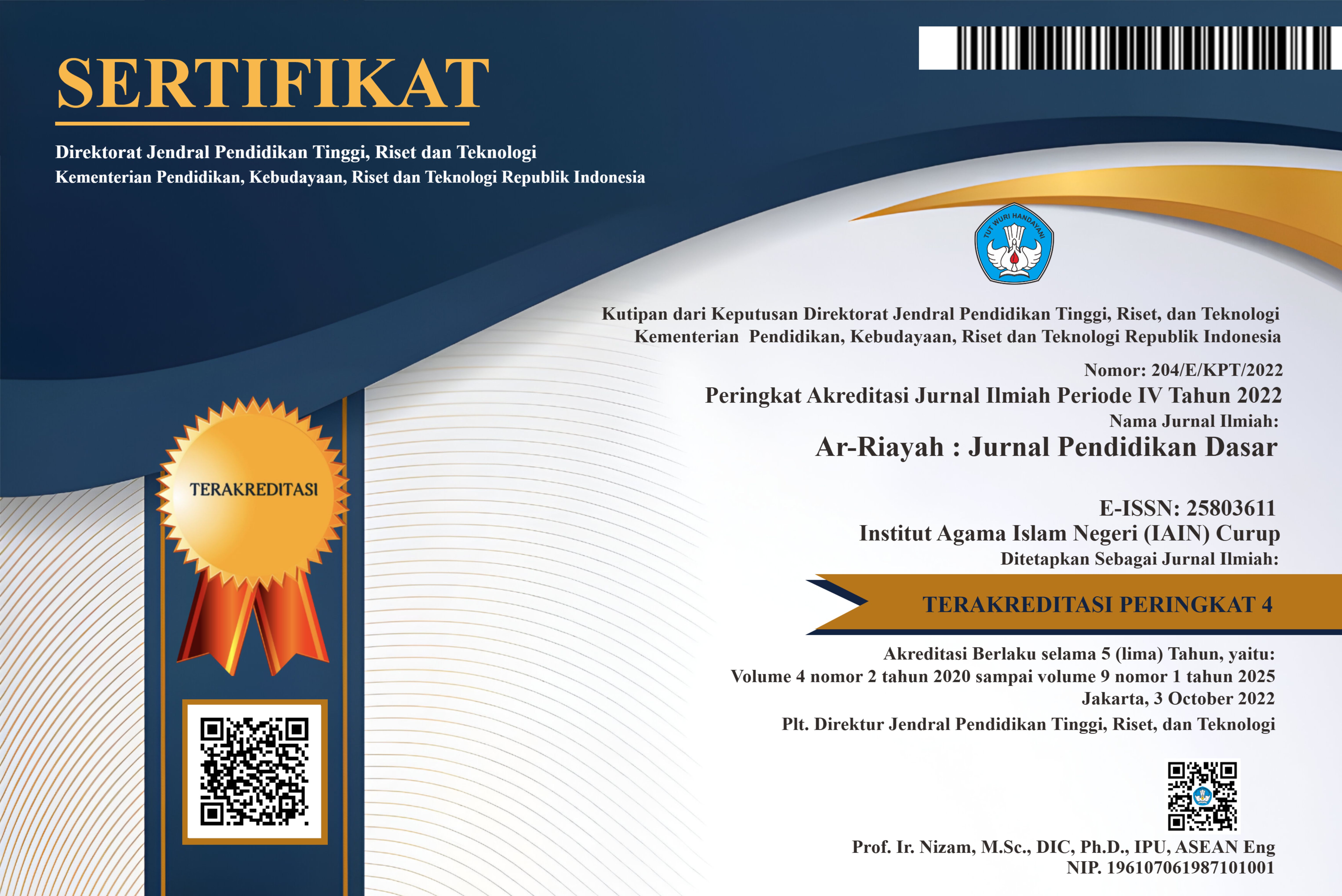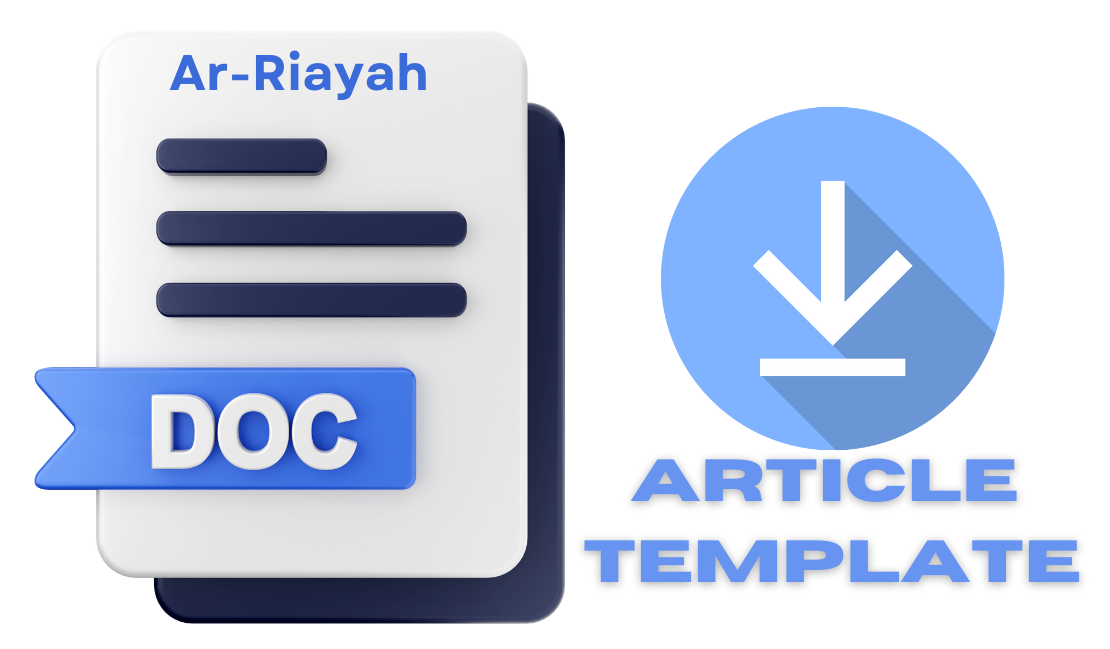Meningkatkan Kemampuan Berpikir Kritis Peserta Didik MI Melalui Model Pembelajaran Inkuiri
DOI:
https://doi.org/10.29240/jpd.v8i1.9812Keywords:
Critical Thinking, Inquiry ModelAbstract
The study of improving critical thinking skills has garnered attention worldwide, including in Indonesia, amidst the developments and advancements of the 21st century. The enhancement of critical thinking skills among students is often overlooked by teachers in the classroom. This research aims to analyze students' critical thinking abilities using the inquiry learning model. The research design employed in this study is quantitative research with a quasi-experimental design. The sample consisted of 61 fifth-grade students from an Islamic elementary school. The findings indicate a significant comparison of students' critical thinking abilities using the inquiry learning model, as revealed by the t-test results. The implications of this research can serve as a reference for taking further action to address issues related to improving critical thinking skills and fostering innovative learning approaches. This study is expected to be utilized by educators as a reference to enhance students' thinking abilities.
Downloads
References
Adigun, Olufemi Timothy. “Computer-Assisted Instruction, Project Based Learning and Achievement of Deaf Learners in Biology.†Journal of E-Learning and Knowledge Society 16, no. 1 (2020): 23–32. https://doi.org/10.20368/1971-8829/1135190.
Akihary, Wilma, Rita Fransina Maruanaya, Carolina Lestuny, and Seplinovye Penina Maruanaya. “The YouTube-Assisted Discovery Learning Model: Improving Students’ Cognitive Learning Outcomes and Critical Thinking.†Journal of Education and Learning (EduLearn) 17, no. 4 (2023): 548–54. https://doi.org/10.11591/edulearn.v17i4.20851.
Anazifa, R. D., and Djukri. “Project- Based Learning and Problem- Based Learning: Are They Effective to Improve Student’s Thinking Skills?†Jurnal Pendidikan IPA Indonesia 6, no. 2 (2017): 346–55. https://doi.org/10.15294/jpii.v6i2.11100.
Azrai, Eka Putri, Daniar Setyo Rini, Mathias Bagas Kurnianto, and Johsamer Ampang. “Ar Sinaps: Augmented Reality Learning Media To Enhance Critical Thinking Ability.†International Journal of Education 16, no. 2 (2023): 109–22. https://doi.org/10.17509/ije.v16i2.50329.
Darling-Hammond, Linda, and Maria E. Hyler. “Preparing Educators for the Time of COVID … and Beyond.†European Journal of Teacher Education 43, no. 4 (2020): 457–65. https://doi.org/10.1080/02619768.2020.1816961.
Elliott, Brett, Karla Oty, John McArthur, and Bryon Clark. “The Effect of an Interdisciplinary Algebra/Science Course on Students’ Problem Solving Skills, Critical Thinking Skills and Attitudes towards Mathematics.†International Journal of Mathematical Education in Science and Technology 32, no. 6 (2001): 811–16. https://doi.org/10.1080/00207390110053784.
Escolà -Gascón, Ãlex, Neil Dagnall, and Josep Gallifa. “Critical Thinking Predicts Reductions in Spanish Physicians’ Stress Levels and Promotes Fake News Detection.†Thinking Skills and Creativity 42, no. July (2021). https://doi.org/10.1016/j.tsc.2021.100934.
Facione, Peter A. “Critical Thinking : A Statement of Expert Consensus for Purposes of Educational Assessment and Instruction Executive Summary “ The Delphi Report.†The California Academic Press 423, no. c (1990): 1–19. http://www.insightassessment.com/pdf_files/DEXadobe.PDF.
Fisher, Elizabeth A. “Motivation and Leadership in Social Work Management: A Review of Theories and Related Studies.†Administration in Social Work 33, no. 4 (2009): 347–67. https://doi.org/10.1080/03643100902769160.
Gunawan, G., A. W. Jufri, N. Nisrina, A. Al-Idrus, A. Ramdani, and A. Harjono. “Guided Inquiry Blended Learning Tools (GI-BL) for School Magnetic Matter in Junior High School to Improve Students’ Scientific Literacy.†Journal of Physics: Conference Series 1747, no. 1 (2021). https://doi.org/10.1088/1742-6596/1747/1/012034.
Hakim, Hikmad, Hasmyati Hasmyati, Muhammad Zulfikar, Nur Indah Atifah Anwar, Hezron Alhim Dos Santos, and Alimin Hamzah. “Improving Student’s Self-Efficacy through Inquiry Learning Model and Modeling in Physical Education.†Cakrawala Pendidikan 42, no. 2 (2023): 483–92. https://doi.org/10.21831/cp.v42i2.57759.
Helmon, Arnoldus. “Developing a PBL-Based Thematic-Integrative Learning Instrument for Grade IV Students.†Jurnal Prima Edukasia 5, no. 2 (2017): 125–38.
Jumaat, Nurul Farhana, Zaidatun Tasir, Noor Dayana Abd Halim, and Zakiah Mohamad Ashari. “Project-Based Learning from Constructivism Point of View.†Advanced Science Letters 23, no. 8 (2017): 7904–6. https://doi.org/10.1166/asl.2017.9605.
Khusna, Arif Hidayatul, Tatag Yuli Eko Siswono, and Pradnyo Wijayanti. “Research Trends in Critical Thinking Skills in Mathematics: A Bibliometric Study.†International Journal of Evaluation and Research in Education (IJERE) 13, no. 1 (2024): 18. https://doi.org/10.11591/ijere.v13i1.26013.
Kitot, Awg Kasmurie Awg, Abdul Razak Ahmad, and Ahmad Ali Seman. “The Effectiveness of Inquiry Teaching in Enhancing Students’ Critical Thinking.†Procedia - Social and Behavioral Sciences 7, no. 2 (2010): 264–73. https://doi.org/10.1016/j.sbspro.2010.10.037.
Kivunja, Charles. “Teaching Students to Learn and to Work Well with 21st Century Skills: Unpacking the Career and Life Skills Domain of the New Learning Paradigm.†International Journal of Higher Education 4, no. 1 (2014): 1–11. https://doi.org/10.5430/ijhe.v4n1p1.
Kusmaryono, Imam, Universitas Islam, Sultan Agung, Jupriyanto Jupriyanto, Universitas Islam, and Sultan Agung. “A Systematic Literature Review on the Effectiveness of Distance Learning : A Systematic Literature Review on the Effectiveness of Distance Learning : Problems , Opportunities , Challenges , and Predictions.†International Journal of Education Vol. 14 No. 1, April-2021, Pp. 62-69 Vol. 14 No, no. April 2021 (2023): 62–69. https://doi.org/10.17509/ije.v14i1.29191.
Larsson, Kristoffer. “Understanding and Teaching Critical Thinking—A New Approach.†International Journal of Educational Research 84, no. May (2017): 32–42. https://doi.org/10.1016/j.ijer.2017.05.004.
Liu, Ou Lydia, Lois Frankel, and Katrina Crotts Roohr. “Assessing Critical Thinking in Higher Education: Current State and Directions for Next-Generation Assessment.†ETS Research Report Series 2014, no. 1 (2014): 1–23. https://doi.org/10.1002/ets2.12009.
Lynott, Francis J., and Gina L. Bittner. “Moving Toward Developing Inquiry Skills: Inquiry-Based Learning in Physical Education.†Strategies 32, no. 2 (2019): 32–38. https://doi.org/10.1080/08924562.2018.1560135.
Manishimwe, Henriette, William Aino Shivoga, and Venuste Nsengimana. “Enhancing Students’ Achievement in Biology Using Inquiry-Based Learning in Rwanda.†International Journal of Evaluation and Research in Education 12, no. 2 (2023): 809–17. https://doi.org/10.11591/ijere.v12i2.23375.
Masayu Rosyidah & Rafiqa Fijra. Metode Penelitian. Yogyakarta, Indonesia: CV BUDI UTAMA, Yogyakarta, 2021.
Muyassaroh, Izzah, and Septian Mukhlis. “Model Inkuiri Terbimbing Berbantuan Buku Dongeng Movable Berbasis Etnosains Untuk Meningkatkan Literasi Sains Siswa.†AR-RIAYAH: Jurnal Pendidikan Dasar 7, no. 2 (2023): 1. https://doi.org/10.29240/jpd.v7i2.6832.
Nur, Syamsiara, Siti Zubaidah, Susriyati Mahanal, and Fatchur Rohman. “ERCoRe Learning Model to Improve Creative-Thinking Skills of Preservice Biology Teachers.†Journal for the Education of Gifted Young Scientists 8, no. 1 (2020): 549–69. https://doi.org/10.17478/jegys.673022.
OECD (2010). PISA 2009 Results: What Students Know and Can Do. PISA 2009 Results: What Students Know and Can Do. Vol. I, 2012. https://doi.org/10.1787/9789264188716-ar.
Østergaard, Lars Domino. “Inquiry-Based Learning Approach in Physical Education: Stimulating and Engaging Students in Physical and Cognitive Learning.†Journal of Physical Education, Recreation & Dance 87, no. 2 (2016): 7–14. https://doi.org/10.1080/07303084.2015.1119076.
Pratama, Fidya Arie, and Muhammad Iqbal Al-Ghazali. “Penerapan Pendekatan Inquiri Dalam Pembelajaran Ilmu Pengetahuan Sosial Untuk Meningkatkan Kualitas Pembelajaran.†Arji: Action Research Journal Indonesia 1, no. 4 (2019): 205–16.
Puspita, Vivi, and Ika Parma Dewi. “Efektifitas E-LKPD Berbasis Pendekatan Investigasi Terhadap Kemampuan Berfikir Kritis Siswa Sekolah Dasar.†Jurnal Cendekia : Jurnal Pendidikan Matematika 5, no. 1 (2021): 86–96. https://doi.org/10.31004/cendekia.v5i1.456.
Ramdani, Agus, I. Putu Artayasa, Muhammad Yustiqvar, and Nina Nisrina. “Enhancing Prospective Teachers’ Creative Thinking Skills: A Study of the Transition From Structured To Open Inquiry Classes.†Cakrawala Pendidikan 40, no. 3 (2021): 637–49. https://doi.org/10.21831/cp.v40i3.41758.
Riduwan. Dasar-Dasar Statistika. Bandung: Alfabeta, 2003.
Roohr, Katrina C., and Kri Burkander. “Exploring Critical Thinking as an Outcome for Students Enrolled in Community Colleges.†Community College Review 48, no. 3 (2020): 330–51. https://doi.org/10.1177/0091552120923402.
Rosana, D., N. Kadarisman, A. Purwanto, and E. K. Sari. “The Effect of Learning Biophysics with Stem Approach on Science Process Skills and Critical Thinking: Field Study on Application of Na-Aogs for Increasing Soybean Productivity and Growth Rate.†Jurnal Pendidikan IPA Indonesia 10, no. 3 (2021): 447–61. https://doi.org/10.15294/JPII.V10I3.30695.
Seranica, Christinsenia, Agus Abhi Purwoko, and Aliefman Hakim. “Influence of Guided Inquiry Learning Model to Critical Thinking Skills.†Journal of Research & Method in Education 8, no. 1 (2018): 28–31. https://doi.org/10.9790/7388-0801022831.
Sirait, Maruslin. “Model Pembelajaran Berbasis Discovery- Inkuiri Dan Kontribusinya Terhadap Penguatan Kualitas Pembelajaran Di Sekolah Dasar.†AR-RIAYAH : Jurnal Pendidikan Dasar 1, no. 2 (2017): 155. https://doi.org/10.29240/jpd.v1i2.320.
Suharsimi Arikunto. Prosedur Penelitian Suatu Pendekatan Praktik (Prosedur Penelitian: Pendekatan Praktis). Jakarta: Rineka Cipta, 2016.
Sulistyanto, Hernawan, Sofyan Anif, Sutama Sutama, Sabar Narimo, Anam Sutopo, Muhammad Izzul Haq, and Gamal Abdul Nasir. “Education Application Testing Perspective to Empower Students’ Higher Order Thinking Skills Related to The Concept of Adaptive Learning Media.†Indonesian Journal on Learning and Advanced Education (IJOLAE) 4, no. 3 (2022): 257–71. https://doi.org/10.23917/ijolae.v4i3.19432.
Wechsler, Solange Muglia, Carlos Saiz, Silvia F. Rivas, Claudete Maria Medeiros Vendramini, Leandro S. Almeida, Maria Celia Mundim, and Amanda Franco. “Creative and Critical Thinking: Independent or Overlapping Components?†Thinking Skills and Creativity 27 (2018): 114–22. https://doi.org/10.1016/j.tsc.2017.12.003.
Downloads
Additional Files
Published
How to Cite
Issue
Section
Citation Check
License
Authors who publish with Ar-Riayah: Jurnal Pendidikan Dasar agree to the following terms:
Authors retain copyright and grant the journal right of first publication with the work simultaneously licensed under a Creative Commons Attribution-NonCommercial-ShareAlike 4.0 International License (CC BY-NC-SA 4.0) that allows others to share the work with an acknowledgment of the work's authorship and initial publication in this journal.
Authors are able to enter into separate, additional contractual arrangements for the non-exclusive distribution of the journal's published version of the work (e.g., post it to an institutional repository or publish it in a book), with an acknowledgment of its initial publication in this journal.
- Authors are permitted and encouraged to post their work online (e.g., in institutional repositories or on their website) prior to and during the submission process, as it can lead to productive exchanges, as well as earlier and greater citation of published work (See The Effect of Open Access).










